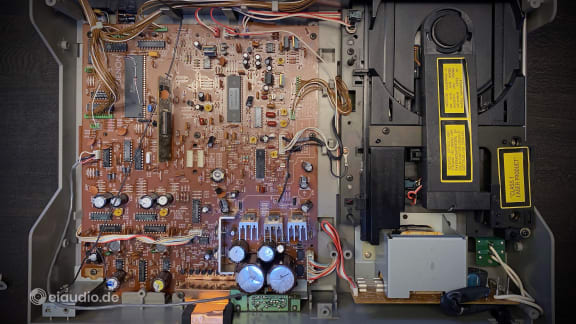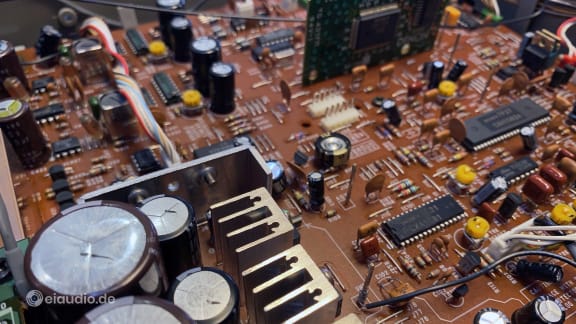Denon DCD 1500 II
Published: 12/04/2021
Manufacturing date: 1986
Author: Karsten Hein
Category: Gear & Review
Tag(s): CD-Players
Having owned the smaller brother, a Denon DCD-1420, for some time now, a look under the hood revealed larger placement markings around the smallish capacitors that showed the dimensions of the parts used on ‘the real thing’, namely, the larger DCD-1500 unit. And, although the DCD-1420 is a reliable middle-class player, even after four decades, I have often asked myself, what I would be hearing, had I bought the fully equipped unit instead.
Therefore, when Luigi showed me two CD-players and asked me which of the two to get, I had a strong leaning towards the Denon DCD-1500 II. The photos we saw showed it in good used condition, but they were far from impressive. Both the Denon’s size and design did not give away its exceptional build quality and internal merits. To me, it looked like just another CD player. This impression changed, when I visited Luigi and saw the player, with its display turned on, perched on a proper HiFi rack. Although its size had not changed and its design was still an understatement, there now was a cleaned-up seriousness about it that made me curious at an instant. This was certainly a whole other beast from my 1420.
Luigi played me a few songs on the Denon DCD-1500 II before he switched to vinyl. While I usually cherish the transition from digital to analog, I noticed that I was a little sad to stop listening to the 1500 so soon. Perhaps this was because the player’s cleaned-up looks had been wonderfully present in the music as well. While the player had not sounded spectacular by any means, the music simply had this air of dependability to it that made it endearing to my ears. I had instantly trusted this player to sound pleasant. The lack of this quality is often an issue with CD players; actually, when audiophiles describe devices as sounding analog or warm, it is sonic dependability rather than spectacle that they are referring to.
Luigi suggested I should take the Denon home with me, explore it further and, perhaps, write a review on it, to which I gladly consented. When I was ready to leave and picked the Denon up from the rack, I was surprised by its weight. For a moment, it felt as if it had been glued to the boards. This aspect of the player is so well hidden, it struck me by surprise, despite having read in the advertisement that it was close to 10kg. Coming from a larger and higher built amplifier, the weight would not have surprised me, but from a standard-looking Japanese consumer device, I was positively surprised.
When I came home, I placed the Denon on our conference table and opened the chassis to look under the hood. While the top cover was made of the same bent metal as is custom on today’s units, I did find a 4mm sheet of lead glued to the inside of the cover. This certainly helps to keep the typical drive and chassis resonances at bay and also increases the player’s resilience in case of resonances coming from the outside. I guess anyone could glue a sheet of lead under the cover of their CD players to the same effect, but thinking of my DCD-1420, I could see how pointless that would be, considering that it was not even made of Denon’s full-size parts.
While performing the first operations on the DCD-1500 II placed in our rack, I noticed that some of the buttons on the front were actually made of metal. This has some advantages when it comes to durability. On our silver 1420 for instance, some of the more frequently used buttons have already lost their silver shine. This was not the case on the 1500. Like many of Denon’s players, the 1500 features both a fixed and a variable output which can be convenient in some cases. For any listening test, I used the fixed output to leave out any unnecessary augmentation to the sound. The CD transport is of excellent quality, and the drawer opens promptly and quickly.
In our living room setup, the 1500 had to compete with the 16-years younger 3.7kg lightweight Rega Planet 2000 CD-player, which was our standard choice for CDs. The interconnect used on both devices was a new type of silver solid core with KLE Innovations silver plugs that had been custom made for eiaudio.de and had not been completely run in. This is to say that bass extension had not completely evolved after two weeks of playing. Since this was our best interconnect at the time, I decided that I would stick with this cable despite this small flaw in the setup. The song played was “No Moon at All” on Diana Krall’s ‘Turn up the Quiet’ album.
The Rega came first and played this song with realistic dimension and tonality. I found that timing could at times have been better, with the player showing a slight tendency of dragging its feet, but overall it was an accurate representation with lots of warmth, musical detail, size, and natural space around the instruments. The DCD-1500 II came next and, in comparison, played slightly darker and fuller with a striking three-dimensional richness in Diana Krall’s voice. It did not present the same amount of detail; however, its timing was more accurate with slightly more drive and consistency to it. The Denon came across as slightly more controlled and dryer with individual notes being stopped earlier. The Rega in comparison appeared to be less predictable, was able to present more of the disc’s nuances, gave a fruitier performance and allowed the music more space to perform.
Both players sounded very pleasing, are excellent companions for extended late night listening sessions and renowned for their warm and analog sound. The Denon is surely the mechanically more sophisticated player, whereas the Rega wins its points on the basis of modern DAC circuitry, a more detailed presentation, and lots of musical charm. Considering that the Rega has a 16-year edge over the Denon, the DCD-1500 II a still very good and worthwhile CD-player, indeed. Its build quality, touch and feel, general usability, and its excellent remote control position it well ahead of today’s mid-market competition.
Testing environment: Denon DCD-1500 II (via HBPS pure silver solid core interconnects to) DB Systems DB1 preamplifier; (via Audiocrast OCC and Silver interconnect to) B&K ST140 power amplifier; (via Belden 9497 speaker cables in bi-wiring to) Martin Logan SL3 electrostatic speakers
Specifications
- Digital Converter: 2 x Burr-Brown PCM56P-J
- CD mechanism: KSS-151A / FG-610
- Frequency response: 2 Hz to 20 kHz
- Dynamic range: 96 dB
- Signal-to-noise ratio (1kHz): 103 dB
- Channel separation: 100 dB
- Total harmonic distortion (1kHz): 0.003%
- Wow and flutter: below measurable
- Power Consumption: 17 W
- Line output (fixed / variable): 2 V (max.)
- Headphones: variable output volume
- Extras: RC 202 remote control, variable line output
- Dimensions: 434 x 107 x 324 mm
- Weight: 9.3 kg
- Country of manufacture: Japan
- Year: 1988





